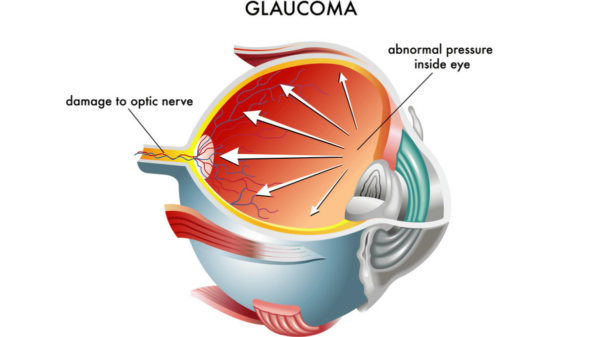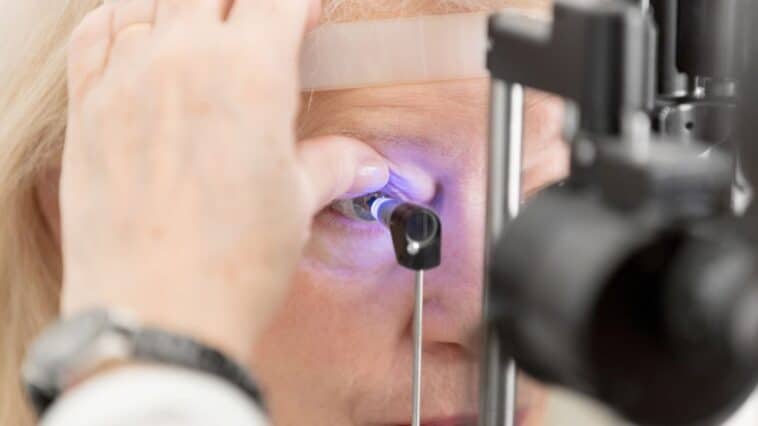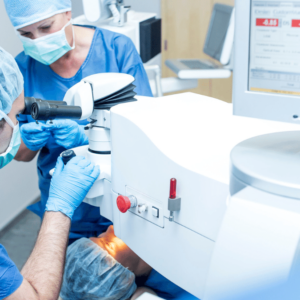What Is Glaucoma?
Glaucoma is an eye condition that affects the optic nerve, which transports visual information from the eye to the brain. It is a group of diseases that damage the optic nerve and can cause permanent visual impairment when not treated promptly. If left untreated, glaucoma can lead to vision loss and blindness.
There are several types of glaucoma, but the most common type is open-angle glaucoma. In this type, the pressure inside the eye (intraocular pressure) gradually increases and damages the optic nerve. However, glaucoma can also occur even if the intraocular pressure is within the normal range, known as normal-tension or low-tension glaucoma.
Other types of glaucoma include angle-closure glaucoma, which occurs when the iris blocks the drainage angle and prevents fluid from leaving the eye, resulting in a sudden rise in intraocular pressure, and congenital glaucoma, which is a rare form of glaucoma that is present at birth and is caused by abnormal development of the eye’s drainage system.
Glaucoma is often asymptomatic in the early stages, often called the “silent thief of sight.” However, as the disease progresses, symptoms may include loss of peripheral vision, blurred vision, halos around lights, and eventual vision loss if left untreated.
Regular eye exams can help detect and diagnose glaucoma early, improving the chances of preserving vision. Treatment typically involves eye drops, laser therapy, or surgery to lower intraocular pressure and prevent further damage to the optic nerve.

Symptoms of Glaucoma
Glaucoma is often called the “silent thief of sight” because it typically has no noticeable symptoms in the early stages. However, as the disease progresses, symptoms may start to appear, including:
- Gradual loss of peripheral vision, often starting with the side vision
- Tunnel vision or a constricted field of vision
- Blurred or hazy vision
- Halos around lights, especially at night
- Pain or redness in the eyes
- Nausea or vomiting (in cases of acute angle-closure glaucoma)
Not everyone with glaucoma will experience symptoms, and some people may experience sudden and severe symptoms in the case of acute angle-closure glaucoma. Regular eye exams, especially for those at higher risk for glaucoma, can help detect the disease early and prevent vision loss.
Types of Glaucoma
There are several types of glaucoma, including:
- Open-angle glaucoma is the most typical form, occurring in roughly 90% of cases. This condition occurs when the natural drainage angle within the eye slowly becomes less efficient. As time passes, this reduces intraocular pressure and can cause lasting damage to optic nerve tissue.
- Angle-closure glaucoma is a serious medical emergency that occurs when the iris part of the eye blocks the fluid drainage from the eyeball and causes an unexpected rise in intraocular pressure. If not treated immediately, it can lead to permanent vision loss.
- Normal-tension glaucoma (NTG) is a type of glaucoma that affects the optic nerve despite having an intraocular pressure that falls within the normal range. The cause of this condition is not well-known, and symptoms can vary depending on the patient. Treatment options may include medications, laser surgery, or traditional surgical procedures.
- Congenital glaucoma is a rare type of eye condition present from birth and is caused by the abnormal development of the eye drainage system.
- Secondary glaucoma is an eye condition resulting from other existing medical issues. It’s typically the consequence of an injury to the eye, inflammation, or even due to certain medications.
- Pigmentary glaucoma is an eye condition in which the drainage angle located at the edge of the iris has become blocked due to pigment granules being released from the iris. This can lead to increased intraocular pressure, causing damage to the optic nerve and a subsequent loss of vision.
- Pseudoexfoliative glaucoma is an eye disorder caused by an accumulation of protein material that blocks the natural drainage angle of the eye, resulting in elevated intraocular pressure.
Each type of glaucoma requires different treatment approaches, and early detection is critical to prevent vision loss.
Causes of Glaucoma
The exact causes of glaucoma are not fully understood, but several factors have been identified that can increase the risk of developing the condition. Some of the causes of glaucoma include:
- High intraocular pressure (IOP): Glaucoma is an eye disorder characterized by increased intraocular pressure (IOP). This occurs when the aqueous humor, the fluid inside the eye, fails to flow correctly through the trabecular meshwork. When this drainage system becomes blocked or is not working correctly, it can cause fluid buildup, leading to elevated IOP and, eventually, glaucoma.
- Age: People aged 60 and over are more likely to develop glaucoma than younger adults, making them a high-risk group for the condition.
- Family history: If you have a history of glaucoma, you’re at a higher risk of developing the condition. So it’s essential to know your family’s history and make sure to get your eyes checked regularly.
- Ethnicity: People of certain ethnicities are more likely to develop glaucoma than others. African Americans, Hispanics, and Asians have a higher risk of developing this condition.
- Other medical conditions: Individuals with other medical conditions, such as diabetes, high blood pressure, and hypothyroidism, are at an increased risk for glaucoma.
- Eye injuries or surgeries: Injury or surgical eye trauma can increase the risk of glaucoma. Some of these traumas may include accidents that cause physical damage to the eye or surgeries that may cause lasting eye complications. Taking proper precautions when dealing with eye-related injuries or operations is important.
- Prolonged use of steroids: Taking steroids for an extended time can put individuals at higher risk for getting glaucoma. Steroid use affects the fluid pressure in the eye, which is associated with the development of glaucoma.
Diagnosis and Treatments
Glaucoma is an eye disease that can gradually damage the optic nerve, leading to vision loss. In some cases, it is caused by high pressure in the eye (intraocular pressure), but it can also occur even with normal or low intraocular pressure levels. Proper diagnosis and timely treatment of glaucoma are essential to prevent further disease progression.
Diagnosis: The diagnosis of glaucoma involves several tests, including:
- Tonometry: This measures the intraocular pressure (IOP) of the eye.
- Visual field test: This measures the patient’s peripheral vision.
- Optical coherence tomography (OCT): This measures the thickness of the optic nerve fibers and can detect early signs of glaucoma.
- Gonioscopy: This examines the eye’s drainage angle to determine if it is open or closed.
- Dilated eye exam: This allows the doctor to examine the optic nerve and retina for signs of damage.
Treatments: The primary goal of treatment for glaucoma is to lower the intraocular pressure to prevent or slow down the progression of vision loss. Treatment options include:
- Eye drops: Medications such as prostaglandin analogs, beta-blockers, and alpha-adrenergic agonists can reduce intraocular pressure.
- Laser therapy: Procedures such as trabeculoplasty and iridotomy can improve fluid drainage from the eye, reducing intraocular pressure.
- Surgery: Surgery is a last resort method used to treat glaucoma, specifically when medical treatments have been unsuccessful in reducing eye pressure. The surgery creates a new drainage channel to reduce fluid buildup in the eye, which causes increased pressure on the optic nerve and can lead to vision loss if left untreated.
- Combination therapy: To effectively manage glaucoma, a variety of treatments may need to be combined. These may include medications, laser therapy, and in some cases, surgery.
It is essential to note that early detection and treatment of glaucoma are crucial to prevent or slow down vision loss. Therefore, regular eye exams are essential, especially for people at higher risk, such as those with a family history of glaucoma or over 60.
Types of Surgery Available
Several types of surgery are available to treat various medical conditions. In the case of glaucoma, the following types of surgeries may be recommended:
- Trabeculectomy: This is the most common type of glaucoma surgery. It involves creating a small flap in the sclera (white part of the eye) and removing a small piece of tissue to create a new drainage channel for the aqueous humor (fluid in the eye) to flow out of the eye. The surgeon may also place a small shunt or tube to help the fluid drain out of the eye.
- Goniotomy: This procedure involves using a special lens to view the angle of the eye and then using a tiny surgical instrument to create a small opening in the trabecular meshwork, the part of the eye that drains the aqueous humor. This opening helps the fluid to drain more easily out of the eye.
- Laser trabeculoplasty: This procedure involves using a laser to open up the drainage channels in the eye. There are two types of laser trabeculoplasty: argon laser trabeculoplasty (ALT) and selective laser trabeculoplasty (SLT). ALT uses a high-energy laser to create small burns in the trabecular meshwork. In contrast, SLT uses a low-energy laser to stimulate the body’s natural healing response to open drainage channels.
- Cyclophotocoagulation: This procedure involves using a laser to destroy part of the ciliary body, the part of the eye that produces the aqueous humor. This reduces the amount of fluid produced and thus lowers intraocular pressure.
The choice of surgery will depend on several factors, including the type and severity of glaucoma, the patient’s overall health, and the surgeon’s preference and experience. Discussing all treatment options with your doctor and asking any questions before deciding on a treatment plan is essential.
Conclusion
Glaucoma is an eye disorder that can cause progressive and permanent damage to vision if not treated in time. Early recognition and management of the condition are critical in helping prevent or slow its progression.
Diagnosis of glaucoma involves several tests to measure intraocular pressure, assess visual fields, and examine the optic nerve and retina for damage.
Treatment options include eye drops, laser therapy, surgery, or a combination. Surgical procedures such as trabeculectomy, glaucoma drainage implants, canaloplasty, and laser trabeculoplasty are available to lower intraocular pressure and improve fluid drainage from the eye. However, any surgical procedure carries some risks, and patients should discuss the benefits and risks with their eye doctor before deciding.
Regular follow-up appointments with the doctor are crucial to monitor the effectiveness of treatment and detect any potential complications.
Glaucoma is a serious condition requiring prompt diagnosis and treatment to preserve vision and maintain quality of life.






